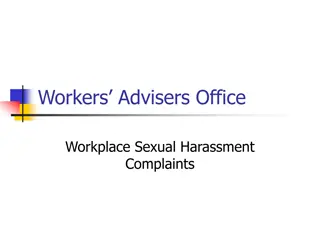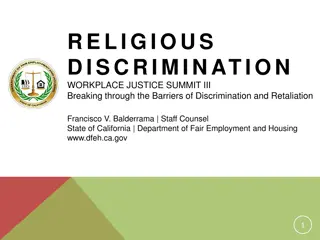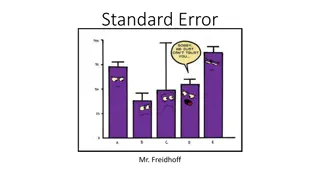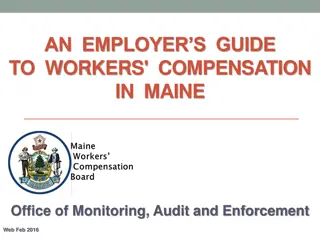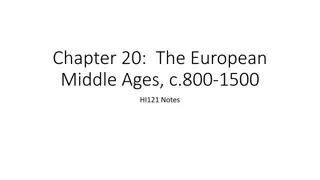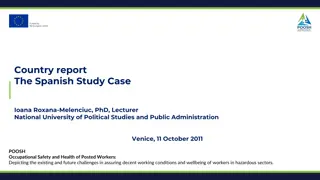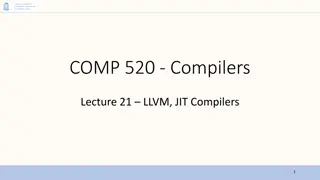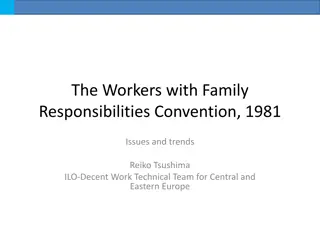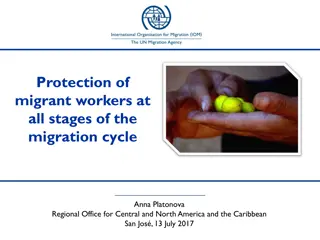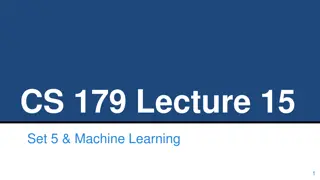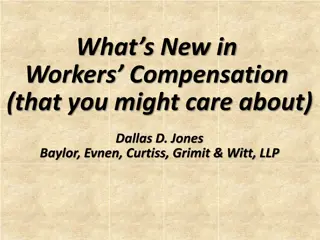Overlapping Challenges in Workers' Comp and FEHA/DFEH
Today's goal is to comprehend the mission and role of DFEH, understand common employer challenges, mistakes, and essential concepts related to disability, discrimination, reasonable accommodation, and the interactive process in the overlap of FEHA and workers' compensation.
Download Presentation

Please find below an Image/Link to download the presentation.
The content on the website is provided AS IS for your information and personal use only. It may not be sold, licensed, or shared on other websites without obtaining consent from the author.If you encounter any issues during the download, it is possible that the publisher has removed the file from their server.
You are allowed to download the files provided on this website for personal or commercial use, subject to the condition that they are used lawfully. All files are the property of their respective owners.
The content on the website is provided AS IS for your information and personal use only. It may not be sold, licensed, or shared on other websites without obtaining consent from the author.
E N D
Presentation Transcript
WORKERS COMP & FEHA/DFEH OVERLAP From a Technical Vantage Point Jacob Barak & Tina Walker
GOAL for TODAY UNDERSTAND DFEH MISSION AND ROLE EMPLOYER CHALLENGES COMMON MISTAKES BASIC UNDERSTANDING Disability, Affirmative Defense, Discrimination, Reasonable Accommodation, & Interactive process FEHA overlap WORK COMP
MISSION STATEMENT The Mission of the Department of Fair Employment and Housing is to protect Californians from employment, housing, and public accommodation discrimination and hate violence
ROLE OF THE DEPARTMENT (DFEH) To receive, investigate and conciliate complaints alleging discrimination in employment, housing, public accommodations and hate violence
Challenges for large employers when Workers Compensation and disability management are handled separately within the organization Strategies to consider: Analysis of policies and procedures for Workers Compensation and disability management Training for supervisors Communication and coordination between the entities that handle Workers Compensation claims, leaves of absence, and disability issues LARGE EMPLOYER Challenges
Human Resource is not well developed or lacks experience with each departing staff member Medium Sized Employer Challenges
No Human Resource Department Nor advisor More reactive rather than proactive, Small Employer Challenges 1man232-med
Common mistakes, basics, and overlap 8 Work Comp Meets FEHA!!
Triggers for Employer Action What triggers an employer s obligations under Workers Compensation? Employers obtains knowledge that a work- related injury has occurred 60 days from Permanent and Stationery vs. 60 days from end of Total Temporarily Disability for Supplemental Job Displacement Benefit What triggers an employer s obligations under FEHA When a supervisor or someone else in management becomes aware that an employee has a disability (whether work- related or not) and needs an accommodation to be able to perform his or her job.
Factors for Considerations Work Comp DFEH/FEHA Time lines/parameters Less than 50 employees More than 50 employees Ramifications for failure to comply Special Circumstances o Seasonal Workers o Undocumented Workers Explanation of employer s obligations to consider reasonable accommodations under the FEHA 5 or more employees Must accommodate unless can show affirmative defense Time lines/ parameters No specific timeframes in FEHA Interactive process should begin once an employer is put on notice
CHALLENGES SURROUNDING MEDICAL INFORMATION Which physician s input (treating Physician, Agreed Medical Examiner, or Qualified Medical Examiner) has the most impact on either process? Resolving differences of opinions on Return to Work status between multiple physicians
CHALLENGES SURROUNDING MEDICAL INFORMATION WORKERS COMP DFEH/FEHA What does the employer need from the physician to conduct the interactive process and look at reasonable accommodations Employer to assess essential functions of job Employee to give to physician/health care practioner Physician/health care practioner to determine employee s work capacities and restrictions What to do when employers do not get information on restrictions until well after the permanent and stationary date
Importance of a timely, good faith interactive process Not delay the process while waiting for pertinent information Reminder of privacy issues for non-occupational cases Employer needs authorization from the employee to contact the physician directly DFEH/FEHA CONTINUED CHALLENGES SURROUNDING MEDICAL INFORMATION
Employers Obligation to Return to Work WORKERS COMPENSATION DFEH/FEHA An Interactive Process is a key part of the obligations Failure to do so, violation of FEHA o CA Government Code Section 12940 (m) Can follow EEOC guidelines o Consulting with employee to identify precise job-related limitations o How these can be overcome with reasonable accommodation o Assess effectiveness Explanation of the employer obligations relative to Return to Work under Workers Compensation Labor Code 4658 Labor Code 4658.1 Cal Code of Regulations 10117
DISABILITY AFFIRMATIVE DEFENSES Inability to Perform Danger To Self Danger to Others Bona Fide Occupational Qualifications Otherwise Required by Law Undue hardship
Should an employer consider modified/alternative work or job accommodations prior to permanent and stationary status? WORK COMP DFEH/FEHA Under the FEHA, does not need to be permanent condition to require an interactive process and job accommodations Using gradual Return to Work plans or transitional duties as part of the overall Return To Work Maximizing Stay-at-Work/Return-to-Work successes Obligation for an ongoing process if something changes along the way (e.g., an employee is accommodated, but later is still having difficulties performing the essential job functions) Must again revisit the process
WHERE EMPLOYER MIGHT MISS THE MARK Areas where employers often miss the mark and ideas for better compliance Only considering a Return to Work and accommodations AFTER an employee is Permanent and Stationary best practice? If already over 60 days from permanent and stationary, thinking why bother? Importance in considering Return to Work even if key Workers Compensation time frames have been missed WHERE EMPLOYEES MIGHT ENCOUNTER FRUSTRATION The more restrictions they have might increase work comp benefits, but it hampers the FEHA side of things
STRATEGIES FOR BOTH WORK COMP AND DFEH/FEHA Strategies for moving the process forward (under Workers Compensation and FEHA) while you gather the information you need Have clear documentation of essential job functions and physical job (and mental, environmental) demands for physician to review and as a basis for the process Start a discussion with the employee about what their challenges have been in performing job functions and BEGIN the process Getting clarification when the physician only provides suggestions for accommodations (or draws conclusions) and does not provide work restrictions/job-related limitations
STRATEGIES FOR BOTH WORK COMP AND DFEH/FEHA Effective verbal and written communication throughout! Document, document, document!
THANK YOU THANK YOU Questions? Questions?



